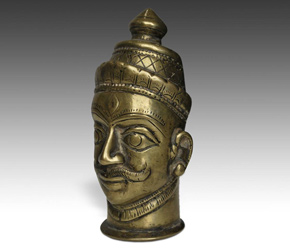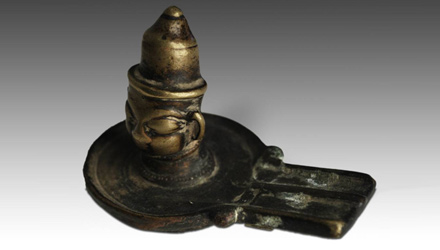As Above So Below – Indian Mukhalingams
PRIMITIVE - Wednesday, October 28, 2015By Misaki Imagawa
 |
|
Meret Oppenheim, a Swiss Surrealist artist in the 1920s, suggested that no matter how beautiful and well crafted a work of art may be, the most important part is the meaning and ideas it reflects. This could describe the world of collecting, which is as much about meaning as it is aesthetics – especially when dealing with religious art. Some religions are so complex, they may seem nearly impossible to comprehend. Hinduism, with a pantheon of deities numbering somewhere between 33 and the thousands is one such religion. It makes sense to say, anyone who can achieve a greater understanding of Hindu gods will certainly enhance their appreciation of Hindu art – not just tenfold or a hundredfold, but a thousandfold!
 |
|
Among the vast pantheon of Hindu deities, three form what is known as the Hindu Triad: Brahma the creator, Vishnu the preserver and protector of humankind, and Shiva the destroyer. In essence, Shiva demolishes the world when the time is right in order for it to be newly created once again. His powers may be fearsome but not evil. He destroys everything that is negative such as ego, illness, unhealthy habits, misfortune and attachments. Shiva's power clears the slate for the creation of new, positive things; replacements, if you will. It is a destruction that is symbolic of cleansing.
 |
|
In India, Shiva has been worshiped for thousands of years. Scholars believe that the deity evolved from the Vedic god Rudra, who is first mentioned in the ancient text known as the Rig Veda, dating between 1700-1100 BCE. It appears that Shiva rose to a position of importance and power in Hinduism by absorbing related characteristics and traits of other deities. Today, Shiva is the supreme god of Shaivism, one of the three largest and most influential sects of Hinduism.
One of the most unique objects related to Shiva worship is the lingam, a sacred egg or phallic shaped object. The lingam is considered to be the ultimate non-representational form of Shiva. While the exact origins of lingams are lost in antiquity, their earliest and most traditional forms are sleek cylindrical shapes with a rounded top made of stone, wood or metal. According to the ancient Hindu scripture Shiva Purana, the lingam is a cosmic pillar of fire with no beginning or end. Fire is symbolic of cleansing. The lingam is also seen as the cause behind all cause, and thus is the symbol of Shiva's infinite and transcendental powers.
 |
|
Around the Kushan period between the 1st and 3rd centuries, Shiva's face began to be carved into lingams. These objects were named mukhalingams, which literally translates as 'lingams with a face.' Mukhalingams may depict anywhere from one to as many as five faces – in which case there would be one for each cardinal direction and one ‘invisible’ face on the top. Each face usually corresponded to a different aspect of Shiva. Often, the number of faces was determined by the shrines they adorned as the number of faces and the directions they faced would correspond with the number of doors in the room of worship. Consequently, depicting two or more faces is not considered better or more auspicious than depicting only one.
In addition to mukhalingams with faces carved directly onto the lingams, the 18th century saw another new form of art: lingam covers. Made of metals such as bronze, copper, brass and sometimes even gold and silver, the covers were cast with Shiva's face and placed over lingams. It was believed that the vibrations of the lingam's powers should be preserved and shielded when not actively worshipped.
No two lingam covers are ever alike, as they were cast using the lost wax technique. In lost wax methodology a model is carved from wax, or for hollow castings such as lingam covers, from a thin layer of wax surrounding a clay core. A mold is then created to surround the wax model. In turn, molten metal is poured into the mold and the wax is displaced. Finally, the mold is broken to reveal the final casting. Using this method it is only possible to create a one-of-a-kind object since the mold and the wax original are destroyed as part of the production process.
 |
 |
||
Many lingam covers share similar features that clearly identify them as Shiva. One is a 'third eye' placed vertically on Shiva’s forehead, which is said to have “burned the emotion of desire to ashes.” Another is his hair, matted and pulled back in linear plaits forming the shape of a seashell. Equally prominent are his bulging eyes and curved mustache. According to legend, Shiva blessed Vasuki, the serpent king, and thereafter wore him as adornment, leading to many iconographic depictions of snakes wrapped around Shiva's body. Consequently, some lingam covers portray Shiva's head resting on Vasuki's coiled body and canopied by his hood.
 |
|
In Hindu tradition, the visual contemplation of deities is considered an important aspect of worship, which is aimed at obtaining the gods' benevolence. However, mukhalingams and lingam covers are also considered something more – they are a visual manifestation of a repeatable prayer or mantra called Namah Shivaya, one of the most popular and important in Shaivism. Associated with healing, divine love and grace, devotees and yogis sing this mantra during prayer to invoke Shiva's blessings; however, the use and presence of mukhalingams and covers is not limited exclusively to temples where formal worship takes place. Millions of households throughout India have their own lingam. Often, they are placed in the kitchen, which is considered a sacred room, and if the household has a separate prayer or “puja” room they are certainly found there too.
Indian art is like an iceberg. The ice that is above water represents the visual form of the work; but the hidden part reaching hundreds of feet below the water represents thousands of years of mythology, iconography, history, cultural context, customs and philosophy giving rise to the art itself. Knowledge of one part brings knowledge of the other. What lies above is also below – visible and invisible – enhancing our appreciation of both. The appreciation of collectibles like lingams, mukhalingams and lingam covers is found in examining and understanding their meaning and the ideas they represent – not just their beauty, which is the tip of the iceberg.
 |